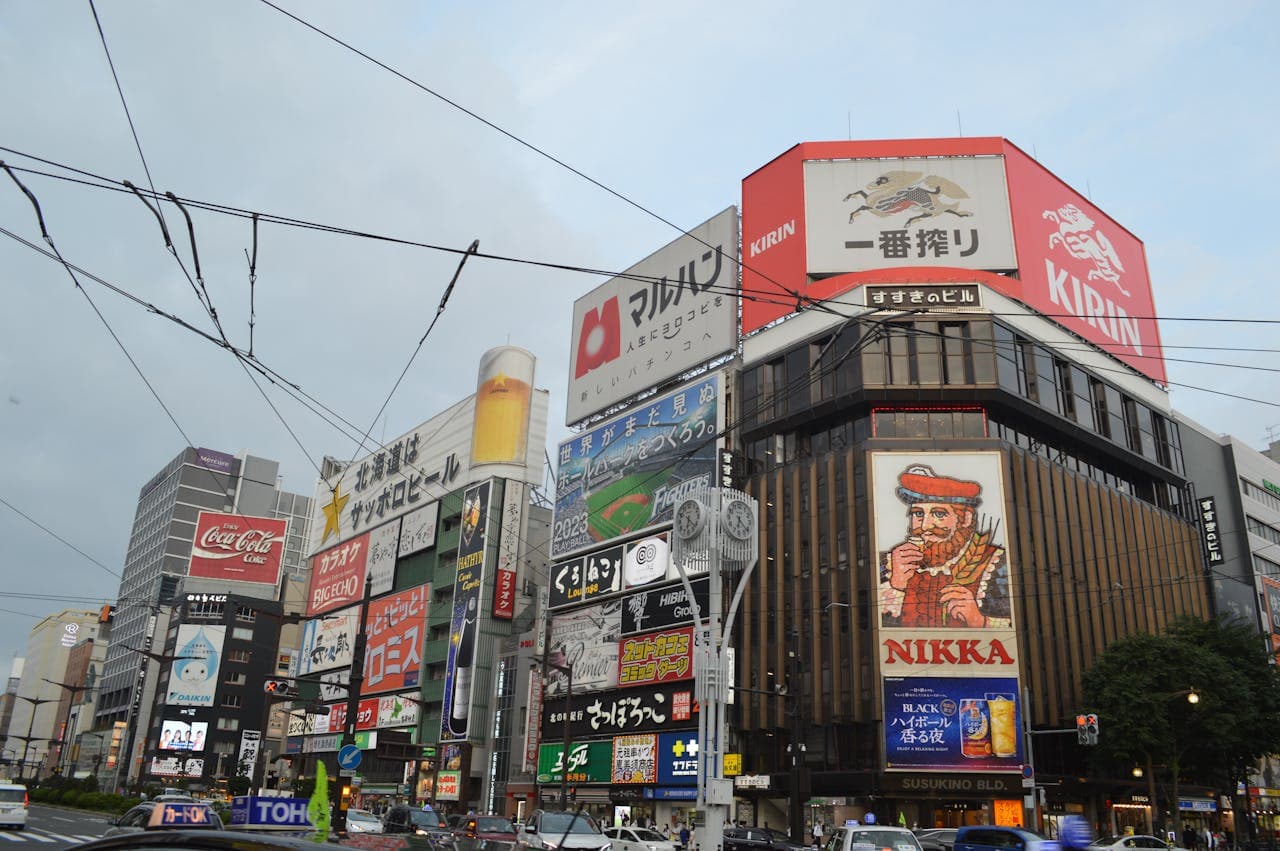What To Do InSapporo
Urban grids, snowy winters, and famous miso ramen—Sapporo mixes modern living with frontier spirit and wide northern skies.

What does Sapporo Look Like?
Sapporo spreads over a flat grid tucked between mountains and sea. Winters bring deep snow and clear, dry air; summers are mild and festival-filled. The city core strings together Sapporo Station, Odori, and Susukino—easy to walk, warmer through underground paths.
Expect wide avenues, red-brick heritage buildings, and nature close at hand—ropeways, parks, and hot springs all within city limits.
Major Tourist Spots to Visit
Odori Park
City ParkGreen ribbon through the city, home to the Snow Festival
Stretching 1.5 km through central Sapporo, Odori Park divides the city north–south and hosts seasonal events. In February it's transformed by the Sapporo Snow Festival's giant ice and snow sculptures; in summer, flowerbeds and beer gardens turn it into the city's living room.
Susukino
NightlifeNeon nightlife district, ramen alley, and entertainment
Sapporo's after-dark heart beats in Susukino. Explore tiny counter bars, izakaya, and the famous Ramen Yokocho for steaming bowls of miso ramen topped with butter and corn. In winter, neon lights reflect on fresh snow for a cinematic stroll.
Sapporo Beer Museum
HeritageRed-brick heritage brewery and tasting hall
Learn how Sapporo helped build Japan's beer culture inside a beautifully preserved Meiji-era brewery. Finish with a tasting flight—classic black label, amber ales, and limited brews—then feast on jingisukan (mutton BBQ) next door at the Beer Garden.
Mt. Moiwa
Nice ViewsRopeway to one of Japan’s top night views
Ride the ropeway and Morris Car to the summit for a panoramic sweep of Sapporo’s grid and Ishikari Bay. The observation deck's ‘love lock’ railings and crisp winter air make sunset and night scenes unforgettable.
Hokkaido Shrine & Maruyama Park
ShrinesShinto grounds amid old-growth forest and cherry blossoms
A forested approach leads to Hokkaido Shrine, the spiritual center of Sapporo. Visit during spring hanami in Maruyama Park or on New Year’s hatsumode when locals line up for blessings and sweet amazake.
Explore Sapporo's Unique Districts
From neon Susukino to serene Maruyama, each area has a distinct pace and palette—especially in winter.
Odori / Sapporo Station Area
City CoreShopping, underground pedestrian spaces, and landmarks
Navigate via the vast underground walkway linking Sapporo Station to Odori and Susukino—ideal in winter. Find department stores, observation decks, and access to JR lines for day trips.
Susukino
NightlifeBars, ramen alleys, and neon billboards
After dusk, Susukino glows. Snack-hop between counter bars and casual izakaya, then slurp a miso ramen nightcap in the famous alleys tucked off the main streets.
Maruyama
Green & CalmLeafy neighborhoods, zoo, and Hokkaido Shrine
Tree-lined streets, local bakeries, and tranquil paths through Maruyama Park make this an easy half-day escape. The nearby zoo is family-friendly year-round.
Moerenuma Park
Art & DesignIsamu Noguchi-designed art-park on the city’s edge
An expansive landscape of geometric hills, glass pyramids, and water features blends sculpture with recreation. Great for cycling picnics when the snow melts.
Sapporo's Heritage & Sacred Spaces
Western-style red bricks, wooden clock towers, and Shinto forests—Sapporo’s youth mixes with quiet history.
Hokkaido Shrine
Est. 1869Spiritual heart of the city amid old-growth forest
Shrine buildings in understated cypress, seasonal festivals, and a serene setting draw locals for life events and New Year visits.
Sapporo Clock Tower
Est. 1881Symbolic wooden clock building from Sapporo Agricultural College
A rare survivor of early Sapporo architecture, the clock still chimes over a small museum documenting the city’s frontier history.
Former Hokkaido Government Office (Akarenga)
Est. 1888Red-brick neo-baroque landmark with gardens
Nicknamed ‘Akarenga,’ the building’s galleries and photo-friendly grounds showcase Hokkaido’s development era.
Jozankei Onsen
Est. 19th centuryRiverside hot-spring town in a forested valley
Within Sapporo’s city limits, Jozankei’s ryokan and day baths pair perfectly with autumn colors or snow-dusted scenery in winter.
How to Get Around Sapporo
Subways, streetcars, and snowy sidewalks—once you learn a few local tricks, Sapporo is easy to navigate in any season.
IC Cards (Kitaca, Suica)
Tap-to-ride on JR Hokkaido, subway, streetcar, and buses. Kitaca works across most major IC networks.
Subway & Streetcar
Three subway lines (Namboku, Tozai, Toho) and a heritage streetcar loop cover core sights—great in snowy weather.
Winter Travel
Allow buffer time for snow, wear grippy shoes, and use underground walkways between Sapporo–Odori–Susukino.
JR Day Trips
Rapid trains connect to Otaru in ~35–45 min—easy seaside add-on with canals and glassware.
Buses
Handy for Moerenuma Park and Jozankei Onsen—check Google Maps or Navitime for live times.
Walking & Cycling
Flat grid makes strolling easy in warmer months; rent bikes for Odori–Maruyama–Nakajima loops.
Night Transport
Last subway around midnight; taxis are plentiful in Susukino if you miss the train.
Taxis
Queue at stations or main intersections; show a pinned map for smooth rides in snowfall.